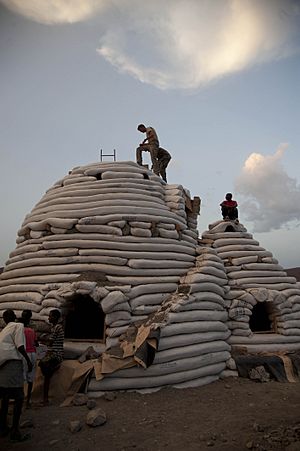Nader Khalili facts for kids
Quick facts for kids
Nader Khalili
|
|
|---|---|
| Born | 1936 Tehran, Iran
|
| Died | March 5, 2008 Los Angeles, California, U.S.
|
| Nationality | Iranian |
| Alma mater | University of Tehran, Istanbul Technical University |
| Occupation | Architect |
| Design | Ceramic house, Earthbag construction, Superadobe |
Nader Khalili (Persian: نادر خلیلی; 1936–2008) was an Iranian-born American architect. He was also an author and a teacher. He is famous for creating unique buildings. These buildings used unusual materials to make homes for people in need, especially after emergencies. His ideas were inspired by old Iranian house designs from dry areas.
Contents
Early Life and Learning
Nader Khalili was born in Tehran, Pahlavi Iran. He grew up in a big family with eight brothers and sisters. He studied Persian literature and poetry at the University of Tehran. Later, he studied engineering and architecture at Istanbul Technical University.
Building a Better World

In 1970, Nader Khalili became a licensed architect in California. He worked on building projects in the U.S. and other countries. In 1975, he was working in Iran for a regular architecture company. He realized his work was not helping to save traditional Iranian building styles.
So, he sold his share of the company. He bought a motorcycle and spent five years living in remote parts of the Iranian desert. His goal was to protect old Iranian architecture. He also wanted to help build homes for people who didn't have much money.
His building ideas came from the traditional homes in his homeland, Iran. He worked with Earth Architecture and helped with development in poorer countries since 1975. He even advised the United Nations on building with earth. Khalili was known for his new ideas. These included the Geltaftan Earth-and-Fire System, also called Ceramic Houses. He also created the Earthbag Construction method, known as Superadobe.
He developed his Superadobe system in 1984. This was in response to a challenge from NASA. NASA wanted ideas for building homes on the moon and Mars. This project was just an idea until the Persian Gulf War in 1990–1991. When refugees came into Iran, Khalili worked with the United Nations Development Programme (UNDP) and the United Nations High Commissioner for Refugees (UNHCR). He used his research to create emergency shelters for them.
In 1991, he started the California Institute of Earth Art and Architecture (Cal-Earth). Here, he taught his Superadobe building technique. Khalili's work became very important in America. He showed that architecture should focus on helping people who need homes the most.
In February 2000, Khalili designed a model for a lunar colony. He used natural materials near the Mojave Desert.
Nader Khalili passed away on March 5, 2008, in Los Angeles. His children, Dastan and Sheefteh, continue his important work today.
Special Recognitions
Nader Khalili received many awards for his amazing work.
- In 1984, he won an award for "Excellence in Technology." This was from the California Council of the American Institute of Architects (CCAIA). It was for his creative Ceramic House System.
- In 1987, he got a special certificate from the U.N. International Year of Shelter for the Homeless. He also received one from the U.S. Department of Housing and Urban Development (HUD). This was for his project "Housing for the Homeless: Research and Education."
- In 2004, Khalili won the famous Aga Khan Award for Architecture. This was for the sandbag shelters he built using Superadobe.
Books by Nader Khalili
Khalili wrote books about his ideas on architecture and building methods. He also translated poems by Rumi. Rumi was a poet who greatly inspired Khalili's designs.
- Khalili, Nader (1983). Racing Alone: A Visionary Architect's Quest for Houses Made with Earth and Fire. Harper & Row. ISBN 9780062504456. https://books.google.com/books?id=ZOFPAAAAMAAJ.
- Khalili, Nader (1986). Ceramic Houses and Earth Architecture: How to Build Your Own. Cal Earth Press. ISBN 9780062504470. https://books.google.com/books?id=B0lUAAAAMAAJ.
- Khalili, Nader (2002). Sidewalks on the Moon: The Journey of a Mystic Architect Through Tradition, Technology, and Transformation. Cal-Earth Press. ISBN 9781889625027.
- Khalili, Nader (2018). The Spiritual Poems of Rumi. Book Sales. ISBN 9781577151678. https://books.google.com/books?id=L4BCDwAAQBAJ.
- Rumi, Fountain of Fire
- Rumi, Dancing the Flame
See Also


